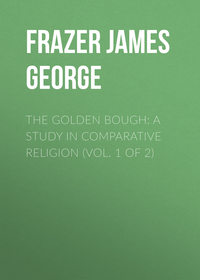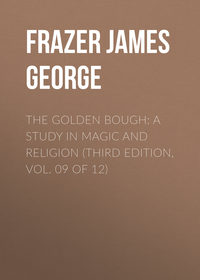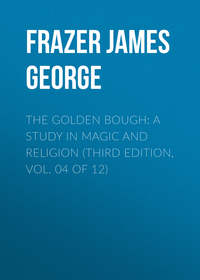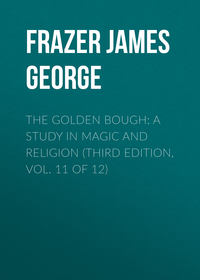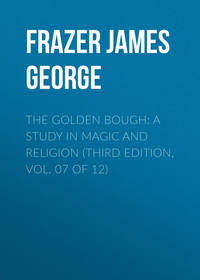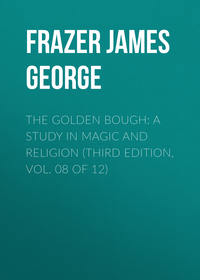
The Belief in Immortality and the Worship of the Dead, Volume 2 (of 3)
664
J. Wilson, op. cit. p. 174.
665
J. Cook, Voyages, i. 193 sq.
666
J. Turnbull, Voyage round the World, p. 364.
667
G. Forster, op. cit. ii. 132.
668
W. Ellis, op. cit. i. 239.
669
W. Ellis, op. cit. i. 243.
670
J. Cook, Voyages, i. 194; J. R. Forster, Observations, pp. 413 sq.; G. Forster, Voyage, ii. 129 sq.; J. Wilson, op. cit. pp. 154 sq., 174, 194 sq.; W. Ellis, op. cit. i. 230 sq., 233, 240. Moerenhout says that when a chief was an Areoi, his first-born son was spared, but all the rest were sacrificed; but immediately afterwards he adds, with apparent inconsistency, that "the first (by which he seems to mean the principal) Areois only killed their first sons and all their daughters; the other male infants were spared." See Moerenhout, op. cit. i. 495, 496. These statements, so far as I have observed, are not confirmed by other writers.
671
J. Cook, i. 194.
672
W. Ellis, op. cit. i. 230 sq., 232 sq.
673
W. Ellis, op. cit. i. 236, 237.
674
W. Ellis, op. cit. i. 238, 241.
675
J. R. Forster, Observations, p. 412; G. Forster, Voyage, ii. 128.
676
W. Ellis, op. cit. i. 236 sq. Compare J. A. Moerenhout, op. cit. ii. 132 sq. According to the latter writer there were traditions of as many as a hundred and fifty canoes sailing at once, each one seldom containing less than thirty or forty, and sometimes a hundred persons.
677
D. Tyerman and G. Bennet, op. cit. i. 326 sq.
678
W. Ellis, op. cit. i. 237 sq.; D. Tyerman and G. Bennet, op. cit. i. 326-328. Compare J. Wilson, op. cit. p. 174, "Wherever they go they exercise power to seize what they want from the inhabitants. They smite their hand on their breast and say 'Harre, give,' whenever they covet any thing, and none dares deny them. They never work; live by plunder; yet are highly respected, as none but persons of rank are admitted among them." This last statement, however, is contradicted by Ellis, who says (op. cit. i. 239) that "the fraternity was not confined to any particular rank or grade in society, but was composed of individuals from every class."
679
J. Wilson, op. cit. p. 197.
680
W. Ellis, op. cit. i. 245 sq., 397; J. A. Moerenhout, op. cit. i. 434 sq.
681
W. Ellis, op. cit. i. 234.
682
Above, p. 258.
683
W. Ellis, op. cit. i. 324, 325.
684
Gerland takes the former view, Moerenhout the latter. See Waitz-Gerland, Anthropologie, vi. 368 sq.; J. A. Moerenhout, op. cit. i. 484. The only evidence adduced by Moerenhout for his interpretation of Oro as a sun-god is a statement that in the Marquesas Islands the Areois suspended their performances and went into retreat from April or May till the vernal equinox (which in the southern hemisphere falls in September), and that during their retreat they assumed the style of mourners and bewailed the absence or death of their god, whom they called Mahoui. This Mahoui is accordingly taken by Moerenhout to be the sun and equated to Oro, the god of the Areois in the Society Islands. But Mahoui seems to be no other than the well-known Polynesian hero Maui, who can hardly have been the sun (see below, p. 286 note5); and Moerenhout's statement as to the annual period of mourning observed by the Areois in the Marquesas Islands is not, so far as I know, confirmed by any other writer, and must, therefore, be regarded as open to doubt. His statement and his interpretation of Oro and Mahoui were accepted by Dr. Rivers, who made them the basis of his far-reaching theory of a secret worship of the sun introduced into the Pacific by immigrants from a far northern country, who also built the megalithic monuments of Polynesia and Micronesia. See W. H. R. Rivers, "Sun-cult and Megaliths in Polynesia," American Anthropologist, xvii. July-September 1915, pp. 431 sqq. In proof of the supposed connexion between these megalithic monuments and a worship of the sun, Dr. Rivers says (p. 440) that the Areois "held their celebrations in an enclosure called marae or marai, at one end of which was situated a pyramidical structure with steps leading to a platform on which were placed the images of the gods during the religious celebrations of the people." But if by "their celebrations" Dr. Rivers means the ordinary dramatic, musical, and athletic performances of the Areois, he seems to be in error; for it appears to be certain that these exhibitions were regularly given, not at the maraes, but in or before large houses built or specially set apart for the purpose. See above, pp. 259 sq.
685
J. Rendel Harris, The Dioscuri in the Christian Legends (London, 1903), pp. 1 sqq. id., The Cult of the Heavenly Twins (Cambridge, 1906), pp. 58 sqq.; id., Boanerges (Cambridge, 1913), pp. 291 sqq.
686
W. Ellis, op. cit. i. 230, 232. Ellis does not admit that Orotetefa and Urutetefa were, strictly speaking, the sons of Oro. He writes: "According to the traditions of the people, Taaroa created, and, by means of Hina, brought forth when full grown Orotetefa and Urutetefa. They were not his sons; oriori is the term employed by the people, which seems to mean create" (op. cit. i. 230). With regard to Hina (Heena), interpreted as the moon, or the goddess of the moon, see J. R. Forster, Observations, p. 549; G. Forster, Voyage, ii. 152; J. A. Moerenhout, op. cit.. i. 428 sq., 458, 472; E. Tregear, Maori-Polynesian Comparative Dictionary, p. 69. s. v. "Hina," "Hina is by far the best known of all Polynesian legendary personages. In the more easterly islands she is a goddess, and is almost certainly the Moon-goddess." Similarly Mr. E. E. V. Collocot observes that Hina "is generally regarded as the Moon-goddess, and this view was spontaneously put forward by a Tongan; in conversation with me" (Journal of the Polynesian Society, xxx. (1921) p. 238).
687
Abundant evidence of the custom is produced by Dr. Rendel Harris in his learned works, The Cult of the Heavenly Twins and Boanerges.
688
The Golden Bough, Part I., The Magic Art and the Evolution of Kings, i. 262 sqq.
689
H. A. Junod, Les Ba-ronga (Neuchâtel, 1898), p. 412; id., Life of a South African Tribe (Neuchâtel, 1912-1913), ii. 394.
690
H. A. Junod, Life of a South African Tribe, ii. 398.
691
H. A. Junod, Life of a South African Tribe, ii. 399.
692
H. A. Junod, Les Ba-ronga, pp. 417 sq.; id., Life of a South African Tribe, ii. 296.
693
H. A. Junod, Life of a South African Tribe, ii. 399 sq.
694
D. Westermann, Die Kpelle, ein Negerstamm in Liberia (Göttingen, 1921), pp. 68, 212, 355. The Bambara, another tribe of West Africa, similarly regard the last-born of twins as the elder of the two. See Jos. Henry, Les Bambara (Münster i. W., 1910), p. 98. So, too, with the Mossi of the Sudan. See E. Mangin, "Les Mossi," Anthropos, x. – xi. (1915-1916) p. 192.
695
L. Martrou, "Les 'Eki' des Fang," Anthropos, i. (1906) p. 751; H. Trilles, Le Totémisme chez les Fân (Münster i. W., 1912), p. 593. Compare H. A. Junod, Life of a South African Tribe, ii. 400, note1, who reports the same superstition among the Fan on the testimony of his wife, who was for years a missionary in the tribe.
696
Above, p. 267.
697
C. Gouldsbury and H. Sheane, The Great Plateau of Northern Nigeria (London, 1911), pp. 307 sq.
698
D. Campbell, In the Heart of Bantuland (London, 1922), p. 155.
699
Dudley Kidd, Savage Childhood (London, 1906), p. 49.
700
J. Roscoe, The Northern Bantu (Cambridge, 1915), p. 235.
701
J. Roscoe, "Further Notes on the Manners and Customs of the Baganda," Journal of the Anthropological Institute, xxxii. (1902) pp. 32-34, 80; id., The Baganda (London, 1911), pp. 64-72. These two accounts to some extent supplement each other. I have drawn on both. As to the annual festival of the god Mukasa, see id., The Baganda, pp. 298 sq.
702
J. Spieth, Die Ewe-Stämme (Berlin, 1906), pp. 202-206.
703
J. M. M. van der Burgt, Dictionnaire Français-Kirundi (Bois-le-Duc, 1903), pp. 324 sq.; H. Meyer, Die Barundi (Leipzig, 1916), pp. 110 sq.
704
W. Ellis, Polynesian Researches, i. 242.
705
Colle, Les Baluba (Brussels, 1913), i. 253-255.
706
J. Irle, Die Herero (Gütersloh, 1906), pp. 96-99.
707
D. Westermann, Die Kpelle, ein Negerstamm in Liberia (Göttingen, 1921), p. 228.
708
D. Tyerman and G. Bennet, op. cit. i. 526.
709
J. A. Moerenhout, op. cit. i. 449 sq.
710
J. Wilson, op. cit. p. 167.
711
D. Tyerman and G. Bennet, op. cit. ii. 40 sq.; W. Ellis, op. cit. ii. 170 sq.
712
D. Tyerman and G. Bennet, op. cit. i. 526.
713
D. Tyerman and G. Bennet, op. cit. i. 141; J. Wilson, op. cit. p. 357; J. Turnbull, Voyage round the World, p. 349; Wallis, in R. Kerr's General History and Collection of Voyages and Travels, xii. 212; id., in J. Hawkesworth's Voyages, i. (London, 1773) p. 483.
714
J. R. Forster, Observations, p. 540; G. Forster, Voyage round the World, ii. 151. These writers spell his name O-Maouwe and O-mauwee.
715
J. Cook, Voyages, i. 156 sq.
716
W. Ellis, op. cit. i. 326 sq. As to the inferior gods, see also J. A. Moerenhout, op. cit. i. 451 sqq.
717
W. Ellis, op. cit. i. 327-329.
718
W. Ellis, op. cit. i. 329 sq. As to the worship of birds, Captain Cook says: "This island [Tahiti] indeed, and the rest that lie near it, have a particular bird, some a heron and others a king's fisher, to which they pay a peculiar regard, and concerning which they have some superstitious notions with respect to good and bad fortune, as we have of the swallow and robin-redbreast, giving them the name of eatua, and by no means killing or molesting them; yet they never address a petition to them, or approach them with any act of adoration." See J. Cook, Voyages, i. 224.
719
W. Ellis, op. cit. i. 329 sq., 331.
720
W. Ellis, op. cit. i. 333 sq.; J. A. Moerenhout, op. cit. i. 440 sqq.; E. Tregear, Maori-Polynesian Comparative Dictionary, pp. 30 sq., s. v. "atua." Captain Cook and the first missionaries spelled the word eatua or eatooa. See J. Cook, Voyages, i. 221, vi. 149; J. Wilson, op. cit. p. 343.
721
W. Ellis, op. cit. i. 324 sq.; J. A. Moerenhout, op. cit. i. 454 sq.
722
W. Ellis, Polynesian Researches, i. 339 sqq. Compare J. Cook, Voyages, i. 157 sqq., 217, 219, 220, 222, vi. 37, sq., 41; J. R. Forster, Observations made during a Voyage round the World, pp. 543 sqq.; G. Forster, Voyage round the World, i. 267, ii. 138 sq.; J. Wilson, op. cit. pp. 207 sq., 211 sq.; D. Tyerman and G. Bennet, op. cit. i. 267 sq., 271, 280 sqq., 549, ii. 13 sq.; J. A. Moerenhout, op. cit. i. 466-470; A. Baessler, Neue Südsee-Bilder, pp. 111 sqq.; S. and K. Routledge, "Notes on some Archaeological Remains in the Society and Austral Islands," Journal of the Royal Anthropological Institute, li. (1921) 438 sqq. According to J. R. Forster (l. c.), the marais (morais, maraes) "consist of a very large pile of stones, generally in the shape of an Egyptian pyramid, with large steps; sometimes this pyramid makes one of the sides of an area, walled in with square stones and paved with flat stones: the pyramid is not solid, but the inside is filled with smaller fragments of coral stones."
723
A. Baessler, Neue Südsee-Bilder, p. 135. This writer has given us a survey and description of some of the principal remains which existed at the end of the nineteenth century (pp. 111-148). The ruins of two maraes in the island of Moorea are described by Mr. and Mrs. Routledge (l. c.). In one of them the pyramid stood at the western end of the enclosure, and in the other at the eastern end.
724
J. Cook, Voyages, i. 157-159. The great pyramid was afterwards visited and described by the first missionaries. Their measurements confirm, while slightly exceeding, those of Captain Cook. They speak, however, of ten steps instead of eleven, and say that the lowest step was six feet high and the rest about five. See J. Wilson, op. cit. pp. 207 sq., with the plate.
725
D. Tyerman and G. Bennet, op. cit. i. 265 sq.
726
D. Tyerman and G. Bennet, op. cit. i. 13 sq.
727
W. Ellis, op. cit. i. 341.
728
D. Tyerman and G. Bennet, op. cit. ii. 13.
729
W. Ellis, op. cit. i. 341 sq.
730
J. Wilson, op. cit. p. 351.
731
Above, pp. 116 sqq.
732
J. Cook, Voyages, i. 217.
733
J. Cook, op. cit. i. 219.
734
J. Cook, Voyages, vi. 37.
735
J. Cook, Voyages, vi. 40 sq.
736
G. Forster, Voyage round the World, i. 267.
737
D. Tyerman and G. Bennet, op. cit. i. 271.
738
D. Tyerman and G. Bennet, op. cit. i. 280.
739
W. Ellis, op. cit. i. 405. See above, pp. 117 sq.
740
J. Wilson, op. cit. p. 364.
741
J. A. Moerenhout, op. cit. i. 470.
742
A. Baessler, Neue Südsee-Bilder, pp. 116 sq., 127 sq., 144 sq.
743
A. Baessler, op. cit. pp. 130, 131.
744
A. Baessler, op. cit. p. 119.
745
A. Baessler, op. cit. pp. 117 sq.
746
A. Baessler, op. cit. pp. 130 sq.
747
A. Baessler, op. cit. p. 140.
748
A. Baessler, op. cit. p. 127.
749
A. Baessler, op. cit. pp. 124, 141.
750
A. Baessler, op. cit. pp. 127 sq., 144 sq.
751
See below, p. 311.
752
Ellis says, "I am not aware that they rendered divine homage either to the sun or moon" (Polynesian Researches, iii. 171). Speaking of the Areois, Moerenhout says that "it seems to me clear that though they did not adore directly the sun and the other stars, nevertheless their worship was little else than sabeism or the adoration of the visible and animated universe" (op. cit. i. 503). He interpreted both Oro and Maui or Mahoui (as he spells the name) as the sun-god (op. cit. i. 484, 502, 503, 560 sq.); but these interpretations appear to be his own guesses, unsupported by any statement of the natives. Maui was the great Polynesian hero, one of whose most famous exploits was catching the sun in a snare and compelling him to move more slowly (E. Tregear, Maori-Polynesian Comparative Dictionary, pp. 234 sqq., s. v. "Maui"; see above, p. 275); but this story, far from favouring the identification of Maui with the sun, seems fatal to it. According to J. R. Forster, the great god Taroa (Taaroa) was thought to have created the sun and to dwell in it (Observations, p. 540); but even if this statement is correct, it hardly implies a worship of the sun. With regard to the moon, the same writer tells us (l. c.) that it was supposed to be procreated by a goddess named O-Heena, "who presides in the black cloud which appears in this luminary"; and the statement is repeated by his son, George Forster, who adds: "The women sing a short couplet, which seems to be an act of adoration paid to that divinity [O-Heena], perhaps because they suppose her to have some influence upon their physical œconomy… 'The cloud within the moon, that cloud I love'" (Voyage round the World, ii. 152). This so far seems to imply a reverence for the moon; and there are some grounds for thinking that O-Heena or Hina (as the name is usually spelt) was in Eastern Polynesia a moon-goddess. See above, p. 267, note2.
753
W. Ellis, op. cit. i. 331 sq., iii. 171. According to another account, the sun and moon in eclipse were supposed to be in the act of copulation. See J. Wilson, op. cit. p. 346.
754
J. A. Moerenhout, op. cit. i. 468.
755
W. Ellis, op. cit. i. 348 sq.
756
J. Cook, Voyages, i. 224; J. R. Forster, Observations made during a Voyage round the World, p. 547; J. A. Moerenhout, op. cit. i. 469. Elsewhere (vi. 149) Captain Cook mentions that the baring of the body on the approach to a temple was especially incumbent on women, who otherwise had to make a considerable circuit to avoid the sacred edifice.
757
J. A. Moerenhout, op. cit. i. 469 sq.; A. Baessler, Neue Südsee-Bilder, pp. 126 sq.
758
J. A. Moerenhout, op. cit. i. 536 sq.
759
W. Ellis, op. cit. i. 271 sq.
760
D. Tyerman and G. Bennet, op. cit. i. 558.
761
D. Tyerman and G. Bennet, op. cit. i. 267 sq.
762
A. Baessler, Neue Südsee-Bilder, pp. 124, 141; D. Tyerman and G. Bennet, op. cit. i. 529 sq.
763
A. Baessler, op. cit. p. 142.
764
A. Baessler, op. cit. p. 146.
765
W. Ellis, op. cit. i. 337 sq.; J. A. Moerenhout, op. cit. i. 471. According to Ellis, the wooden images were made from the durable timber of the aito or casuarina tree, and the stone images were mostly rude uncarved angular columns of basalt, of various sizes, though some were of calcareous or siliceous stone. Some stone images, however, were rudely carved in human form. See A. Baessler, Neue Südsee-Bilder, pp. 128 sq.
766
W. Ellis, op. cit. i. 354.
767
W. Ellis, op. cit. i. 338 sq.; J. A. Moerenhout, op. cit. i. 471 sqq.
768
J. A. Moerenhout, op. cit. i. 473 sq.
769
W. Ellis, op. cit. i. 344 sq.
770
W. Ellis, op. cit. i. 345-348. Compare J. Cook, Voyages, iii. 168 sqq. vi. 28-41; J. Wilson, op. cit. pp. 350 sq.; D. Tyerman and G. Bennet, op. cit. i. 549, ii. 38 sq.
771
W. Ellis, op. cit. i. 342 sq. Compare J. R. Forster, Observations made during a Voyage round the World, pp. 545 sqq.; J. A. Moerenhout, op. cit. i. 474 sqq.
772
J. Wilson, op. cit. p. 348.
773
J. Cook, Voyages, i. 223.
774
D. Tyerman and G. Bennet, op. cit. i. 279.
775
J. Wilson, op. cit. pp. 349 sq.
776
W. Ellis, op. cit. i. 373-375.
777
W. Ellis, op. cit. i. 373 sq.
778
D. Tyerman and G. Bennet, op. cit. i. 124.
779
D. Tyerman and G. Bennet, op. cit. i. 114 sq.
780
D. Tyerman and G. Bennet, op. cit. i. 121.
781
J. A. Moerenhout, op. cit. i. 504-507.
782
G. Forster, Voyage round the World, ii. 151 sq. Compare J. R. Forster, Observations made during a Voyage round the World, pp. 534 sq., 542 sq., where the word for soul is given as E-teehee or Teehee.
783
J. A. Moerenhout, op. cit. i. 431.
784
G. Forster, op. cit. ii. 151 note *.
785
J. Cook, op. cit. vi. 151.
786
J. A. Moerenhout, op. cit. i. 430.
787
J. Wilson, op. cit. p. 346. In the Polynesian languages po is the word both for "night" and for "the shades," the primaeval darkness from which all forms of life were evolved, and to which the souls of the dead return. See E. Tregear, Maori-Polynesian Comparative Dictionary, p. 342, s. v. "po."
788
W. Ellis, Polynesian Researches, i. 378 sq.
789
Compare W. Ellis, op. cit. i. 396, "What their precise ideas of a spirit were, it is not easy to ascertain. They appear, however, to have imagined the shape or form resembled that of the human body, in which they sometimes appeared in dreams to the survivors."
790
J. Cook, op. cit. vi. 150.
791
J. A. Moerenhout, op. cit. i. 507.
792
W. Ellis, op. cit. i. 395; J. A. Moerenhout, op. cit. i. 433, 538 sqq.


